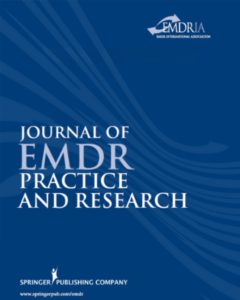Psychophysiological Studies of EMDR (Journal of EMDR Practice and Research)
This article describes research on the effects of eye movements during authentic EMDR sessions of chronic PTSD in refugees of war and torture.
Read MoreThe Neurobiology of EMDR: Exploring the Thalamus and Neural Integration (Journal of EMDR Practice and Research)
One underlying mechanism of EMDR stimulation (BLS) is likely thalamic activation specifically of the ventrolateral and central-lateral nuclei.
Read MoreEMDR and the Adaptive Information Processing Model: Potential Mechanisms of Change (Journal of EMDR Practice and Research)
Throughout the article a variety of mechanisms of action are discussed, including those inferred by tenets of the AIP model, and the EMDR procedures themselves, including the bilateral stimulation.
Read MoreReduced misinformation effects following saccadic bilateral eye movements (Brain and Cognition)
The effects of saccadic bilateral (horizontal) eye movements on memory for a visual event narrative were investigated.
Read MoreEffects of eye movement versus therapist instructions on the processing of distressing memories (Journal of Anxiety Disorders)
The effectiveness of EMDR was tested by randomly assigning 48 participants to either an eye movement or an eye stationary condition.
Read MoreEffects of bilateral eye movement on retrieval of item, associative and contextual information (Neuropsychology)
Two experiments investigated the effects of saccadic bilateral eye movements on the retrieval of item, associative, and contextual information. Bilateral eye movements increased correct recall for both types of context.
Read MoreRapid eye movements for acute stress disorder using video conference communication (Telemedicine and e-Health)
The authors present a patient suffering from an acute stress disorder, treated by rapid eye movements through telepsychiatry services.
Read MoreEffect of bilateral eye movements on frontal interhemispheric gamma EEG coherence: implications for EMDR therapy (The Journal of Nervous and Mental Disease)
The present study examined the effects of the eye movements used in EMDR on interhemispheric electroencephalogram coherence.
Read MoreEffects of bilateral eye movements on gist based false recognition in the DRM paradigm (Brain and Cognition)
The effects of saccadic bilateral (horizontal) eye movements on gist based false recognition was investigated.
Read MoreThe active ingredient in EMDR: Is it traditional exposure or dual focus of attention? (Clinical Psychology and Psychotherapy)
Is EMDR similar to traditional exposure treatments (reliving), or more consistent with distancing (dual process of attention)?
Read MoreIncreased interhemispheric interaction is associated with earlier offset of childhood amnesia (Neuropsychology)
Results of two experiments build upon a growing body of research indicating an interhemispheric basis for the retrieval of episodic memories.
Read MoreBilateral eye movements enhance the retrieval of episodic memories (Neuropsychology)
Thirty seconds of horizontal saccadic eye movements preceding testing resulted in selective enhancement of episodic memory retrieval.
Read More


